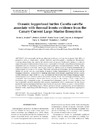Identificador persistente para citar o vincular este elemento:
https://accedacris.ulpgc.es/handle/10553/72187
| Título: | Oceanic loggerhead turtles Caretta caretta associate with thermal fronts: evidence from the Canary Current Large Marine Ecosystem | Autores/as: | Scales, Kylie L. Miller, Peter I. Varo-Cruz, Nuria Hodgson, David. J. Hawkes, Lucy A. Godley, Brendan J. |
Clasificación UNESCO: | 251005 Zoología marina | Palabras clave: | Central North Pacific Longline Fishing Grounds Olivacea Sea-Turtles Satellite Tracking Phytoplankton Blooms, et al. |
Fecha de publicación: | 2015 | Publicación seriada: | Marine Ecology - Progress Series | Resumen: | Oceanographic fronts are physical interfaces between water masses that differ in properties such as temperature, salinity, turbidity and chlorophyll a enrichment. Bio-physical coupling along fronts can lead to the development of pelagic biodiversity hotspots. A diverse range of marine vertebrates have been shown to associate with fronts, using them as foraging and migration habitats. Elucidation of the ecological significance of fronts generates a better understanding of marine ecosystem functioning, conferring opportunities to improve management of anthropogenic activities in the oceans. This study presents novel insights into the oceanographic drivers of habitat use in a population of marine turtles characterised by an oceanic-neritic foraging dichotomy. Using satellite tracking data from adult female loggerhead turtles Caretta caretta nesting at Cape Verde (n = 12), we tested the hypothesis that oceanic-foraging loggerheads associate with mesocale (10s to 100s of km) thermal fronts. We used high-resolution (1 km) composite front mapping to characterise frontal activity in the Canary Current Large Marine Ecosystem over 2 temporal scales: (1) seasonal front frequency and (2) 7 d front metrics. Our use-availability analysis indicated that oceanic loggerheads show a preference for the highly productive upwelling region between Cape Verde and mainland Africa, an area of intense frontal activity. Within the upwelling region, turtles appear to forage epipelagically around mesoscale thermal fronts, exploiting profitable foraging opportunities resulting from physical aggregation of prey. | URI: | https://accedacris.ulpgc.es/handle/10553/72187 | ISSN: | 0171-8630 | DOI: | 10.3354/meps11075 | Fuente: | Marine Ecology Progress Series [ISSN 0171-8630], v. 519, p. 195-207, (Enero 2015) |
| Colección: | Artículos |
Citas SCOPUSTM
30
actualizado el 30-mar-2025
Citas de WEB OF SCIENCETM
Citations
30
actualizado el 30-mar-2025
Visitas
100
actualizado el 11-may-2024
Descargas
113
actualizado el 11-may-2024
Google ScholarTM
Verifica
Altmetric
Comparte
Exporta metadatos
Los elementos en ULPGC accedaCRIS están protegidos por derechos de autor con todos los derechos reservados, a menos que se indique lo contrario.
